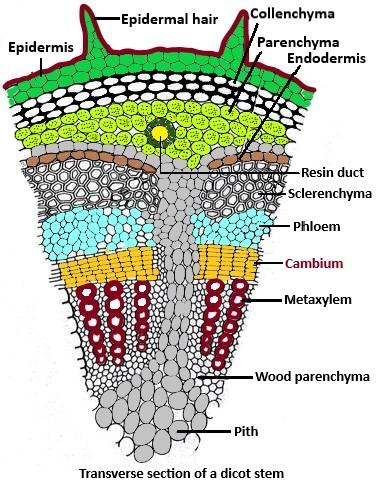
The cambium located in between xylem and phloem in the dicot stem is
A. Interfascicular
B. Intrafascicular
C. Both A and B
D. None of the above
Answer
475.2k+ views
Hint: Plants can be classified as non-flowering and flowering plants which are further divided into two categories that include monocotyledons and dicotyledons. Cotyledons are present in seed-bearing plants and are called the embryonic leaf.
Complete answer: The dicot stem is a part of the dicotyledons. Dicotyledons are flowering plants that consist of two embryonic leaves also known as cotyledons as mentioned earlier. Dicot stems consist of an epidermis which comprises cuticle and multicellular stem hair. A dicot stems internal structure consists of epidermis, cortex endodermis (Collenchyma, parenchyma, and endodermis), pericycle (sclerenchyma), vascular bundles (xylem, phloem, cambium, and wood parenchyma), and a pith. Examples of flowering plants that have a dicot stem include Cucurbita and sunflower.
The cambium is a layer of cells that divides phloem and xylem tissues. The cambium cells are responsible for the stem girth expansion, the secondary growth of roots, and the stem. The cambium which is located within the vascular bundles, that is between the primary phloem and primary xylem is called the intrafascicular cambium. Whereas, during the occurrence of secondary growth, interfascicular cambium is formed due to the medullary ray cells becoming meristematic in nature. Both the intrafascicular cambium and interfascicular cambia join to form a cambium ring that separates the primary xylem and phloem.

Therefore, the correct answer is option B, i.e., Intrafascicular.
Note: The shoot system, simply known as the stem provides structural support and carries out functions such as producing new living tissues, transporting nutrients and water from the roots to different parts of the plant such as leaves, flowers, and fruits via xylem and phloem. The Kingdom Plantae consists of about 320,000 different species of plants out of these approximately 100,000 to 150,000 are dicot plant species.
Complete answer: The dicot stem is a part of the dicotyledons. Dicotyledons are flowering plants that consist of two embryonic leaves also known as cotyledons as mentioned earlier. Dicot stems consist of an epidermis which comprises cuticle and multicellular stem hair. A dicot stems internal structure consists of epidermis, cortex endodermis (Collenchyma, parenchyma, and endodermis), pericycle (sclerenchyma), vascular bundles (xylem, phloem, cambium, and wood parenchyma), and a pith. Examples of flowering plants that have a dicot stem include Cucurbita and sunflower.
The cambium is a layer of cells that divides phloem and xylem tissues. The cambium cells are responsible for the stem girth expansion, the secondary growth of roots, and the stem. The cambium which is located within the vascular bundles, that is between the primary phloem and primary xylem is called the intrafascicular cambium. Whereas, during the occurrence of secondary growth, interfascicular cambium is formed due to the medullary ray cells becoming meristematic in nature. Both the intrafascicular cambium and interfascicular cambia join to form a cambium ring that separates the primary xylem and phloem.

Therefore, the correct answer is option B, i.e., Intrafascicular.
Note: The shoot system, simply known as the stem provides structural support and carries out functions such as producing new living tissues, transporting nutrients and water from the roots to different parts of the plant such as leaves, flowers, and fruits via xylem and phloem. The Kingdom Plantae consists of about 320,000 different species of plants out of these approximately 100,000 to 150,000 are dicot plant species.
Recently Updated Pages
The correct geometry and hybridization for XeF4 are class 11 chemistry CBSE

Water softening by Clarks process uses ACalcium bicarbonate class 11 chemistry CBSE

With reference to graphite and diamond which of the class 11 chemistry CBSE

A certain household has consumed 250 units of energy class 11 physics CBSE

The lightest metal known is A beryllium B lithium C class 11 chemistry CBSE

What is the formula mass of the iodine molecule class 11 chemistry CBSE

Trending doubts
State the laws of reflection of light

One Metric ton is equal to kg A 10000 B 1000 C 100 class 11 physics CBSE

Difference Between Prokaryotic Cells and Eukaryotic Cells

How do I convert ms to kmh Give an example class 11 physics CBSE

Describe the effects of the Second World War class 11 social science CBSE

Which of the following methods is suitable for preventing class 11 chemistry CBSE




